#Great Plains Foraging
Text

Month 5, day 4, may the fourth be with you 🖖🏼
Yes I know that's the Vulcan salute from Star Trek, listen, listen, it irks the nerds, and I'm a goddamn troll, okay? Nothing like some good-natured frustrated screaming to make my day
Anywho, tonight I drew more grasses and also redrew the knife! Or at least I did a better(?) outline of it. I still think it's too small and the perspective is off, so I might have to finagle that later. For right now, though, grasses~ I think I like what I have here for differentiating where the dirt ends and the grass starts. When I decide to color this in anime-esque style I'm gonna use a soft edged brush to blend the two
#the great artscapade of 2023#art#my art#forspoken fanart#frey holland#forspoken cuff#hell I'm this close to just tracing over one of the reference pictures I took bc it's basically at the angle I want the knife at anyway#also Frey has a mysterious tool on her belt that I can't tell what it is#but it's right next to her rope and looks like metal so it could be like pitons for climbing?#she also has a straight-edge knife next to her mystery tools!#more like a hunting dagger than anything from the looks of things#not sure what the sickle blade is for#it's not like a farming sickle but I don't think it's for defense or combat either?#maybe it's for cutting through jungle or forest overgrowth or something#or for harvesting/foraging in a wooded area as opposed to the plains or a field?#I'll have to do research#largely for self-insert isekai purposes >w>#what? my SI isn't gonna be a heavy magic user like Frey is#I need to know what melee weapons are available for my SI to use#and if the crescent moon blade strapped to Frey's butt is a weapon I want her to have access to it#if not I need to know what it's for so I can accurately describe its use#assuming it ever comes up#which it might idk I haven't written the damn thing yet#I've started!#twice even!#one has 16k words and went off the rails#the other has 13k and has been brute forced into the outline (so far)#and I'll bet you all the pocket lint I have that In Tanta We Trust is going to make me start a third time >:3#I can't wait~
3 notes
·
View notes
Text
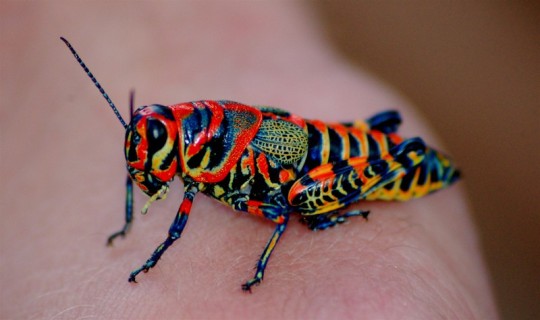
Rainbow Grasshopper (Dactylotum bicolor)
Habitat & Distribution
Mainly found in prairies and agricultural areas
Local to the Great Plains and southwestern United States
Physical Description
Weight: 0.01 oz (0.28 g) on average
Length: 20 mm to 35 mm (0.8 to 1.4 in)
Both sexes have a black base and brightly colored markings over their head and body; these markings can be red, orange, yellow, green, or blue
The rainbow grasshopper does not have wings, and moves only by hopping
Behaviour
Adults feed on a variety of plants, primarily grasses and young shoots
Though not formally social, they tend to congregate in groups for foraging
Predators include possums, raccoons, shrews, foxes, and bats
Key Advantages
Like other grasshoppers, the rainbow grasshopper has a powerful jump
The bright coloration may warn away potential predators, as they mimic other insects which are poisonous
Photo by Jay Iwasaki
406 notes
·
View notes
Text
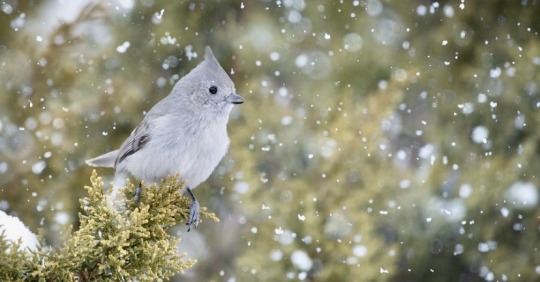



the juniper titmouse is a member of the tit family found in the western united states (primarily the great basin). previously grouped as the ‘plain titmouse’, this species and the oak titmouse were officially separated into two species in 1996 due to range & song differences. the juniper titmouse often dwells in pairs or small groups, but may join larger mixed flocks for foraging. this bird is also a common feeder visitor within their range. they are omnivorous eaters that feed on a variety of insects, berries and fruits, and seeds. both sexes are a uniform soft gray with darker gray wings.
762 notes
·
View notes
Text
tfw you see some stupid post that paints medieval peasants eating just plain grey porridge and acting as if cheese, butter or meat was too exotic or expensive for them, and have to use all your inner strength to not just reblog it with an angry rant and throwing hands with people. so i will just post the angry rant here
no, medieval people did not only eat grey porridge with no herbs or spices, they had a great variety of vegetables we dont even have anymore, grains and dairy products, not to mention fruits and meats, all seasonal and changing with the time of the year. no, medieval food was not just tasteless, maybe this will surprise some of you but you can make tasty food without excessive spice use, and can use a variety of good tasting herbs. if you'd ever tried to cook some medieval recipes you would know that. medieval people needed a lot of energy for their work, if they would only eat fucking porridge all of the time they would get scurvy and die before they could even built a civilisation. they had something called 'pottage' which was called that because it was cooked in one pot. you could leave the pot on the fire and go about your day, doing stuff and come back to a cooked meal. they put in what was available that time of the year, together with grains, peas, herbs, meat etc etc. again, if you would try to make it, like i have with my reenactment friends, it can actually be really good and diverse.
dont confuse medieval peasants with poor people in victorian england. dont think that TV shows what it was really like. dont think that dirty grey dressed people covered in filth were how the people looked like.
they made use of everything. too poor to buy proper meat? buy a sheeps head and cook it. they ate nettle and other plants we consider weeds now. they foraged and made use of what they found. hell, there are medieval cook books!
most rural people had animals, they had chickens (eggs), goats (milk and dairy), cows (milk and dairy), sheep (milk and dairy) and pigs (meat machine), and after butchering they used ALL THE PARTS of the animal. you know how much meat you can get out of a pig, even the smaller medieval breeds? the answer is a lot
if you had the space you always had a vegetable garden. there are ways to make sure you have something growing there every time of the year. as i said they had a variety of vegetables (edit: yes onions are vegetables, for those who dont seem to know) we dont have anymore due to how farming evolved. you smoked pork in the chimney, stored apples in the dry places in your house, had a grain chest. people could go to the market to buy fish and meat, both fresh and dried/smoked. they had ale, beer and wine, that was not a luxury that was a staple part of their diet.
this post ended once again up being longer than i planned, but please for the love of the gods, just actually educate yourself on this stuff and dont just say stupid wrong shit, takk
#personal#medieval#medieval europe#medievalcore#sorry for that rant but man#i hate this so much#please read a book or something#or go on youtube and look up mediev food#there are so many cool food historians on there who make stufd#and show what peiole ate
6K notes
·
View notes
Text
In the late 18th century, [...] Lahaina carried such an abundance of water that early explorers reportedly anointed it “Venice of the Pacific”. A glut of natural wetlands nourished breadfruit trees, extensive taro terraces and fishponds that sustained wildlife and generations of Native Hawaiian families.
But more than a century and a half of plantation agriculture, driven by American and European colonists, have depleted Lahaina’s streams and turned biodiverse food forests into tinderboxes. Today, Hawaii spends $3bn a year importing up to 90% of its food. This altered ecology, experts say, gave rise to the 8 August blaze that decimated the historic west Maui town and killed more than 111 people.
“The rise of plantation capital spawned the drying of the west side of Maui,” said Kamana Beamer, a historian and a former member of the Hawaii commission on water resource management [...].
---
[S]ugar and pineapple white magnates began arriving on the islands in the early 1800s. For much of the next two centuries, Maui-based plantation owners like Alexander & Baldwin and Maui Land & Pineapple Company reaped enormous fortunes, uprooting native trees and extracting billions of gallons of water from streams to grow their thirsty crops. (Annual sugar cane production averaged 1m tons until the mid-1980s; a pound of sugar requires 2,000lb of freshwater to produce.)
Invasive plants that were introduced as livestock forage, like guinea grass, now cover a quarter of Hawaii’s surface area. The extensive use of pesticides on Maui’s pineapple fields poisoned nearby water wells. The dawn of large-scale agriculture dramatically changed land practices in Maui, where natural resources no longer served as a mode of food production or a habitat for birds but a means of generating fast cash, said Lucienne de Naie, an east Maui historian [...].
“The land was turned from this fertile plain – with these big healthy trees, wetland taros and dryland crops like banana and breadfruit – to a mass of monoculture: to rows and rows of sugar cane, and rows and rows of pineapple,” she said.
---
The Great Māhele of 1848, a ground-breaking law that legitimized private land ownership, laid the ground for big developers to hoard water for profit, said Jonathan Likeke Scheuer, a water policy consultant and co-author of the book Water and Power in West Maui. [...] [T]he creation of private property allowed agricultural corporations to wield “political and ultimately oligarchic power” over elected officials. In 1893, a group of sugar magnates and capitalists overthrew the Hawaiian Kingdom’s Queen Liliuokalani, paving the way for the US to annex Hawaii five years later. Sanford Ballard Dole, a cousin of Dole Plantation’s founder, served as the first governor of Hawaii.
When the last of the sugar companies closed in 2016 [...], Scheuer said, the farms were purchased by large investors for real estate speculation and left fallow, overrun with invasive grasses that became fuel for brush fires. Developers [...] took control of the plantations’ century-old irrigation ditches and diverted water to service its luxury subdivisions. In doing so, it left scraps for Indigenous families who lived downstream. [...] [O]n Maui, 16 of the top 20 water users are resorts, time-shares and short-term condominium rentals equipped with emerald golf courses and glittering pools [...].
---
Text by: Claire Wang. "How 19th-century pineapple plantations turned Maui into a tinderbox". The Guardian. 27 August 2023. [Bold emphasis and some paragraph breaks/contractions added by me.]
270 notes
·
View notes
Text
In which the farmer is not quite human. Pt 2: Willy
Willy pulled his old wool coat a little closer to his chest. That battered old flannel had seen more years than some of the younger folk in town. They just didn’t make coats like that anymore. The ocean air was bitingly cold. The fish weren’t really biting today, but he’d stay out until dinner time. He wasn’t the type of man to mix up his routine; even when the fish were being stubborn. The ocean never claimed to be predictable, or even kind. It owed him nothing. Willy simply knew how to withstand the tide.
He doesn’t notice the sound of rhythmic footsteps over the crashing waves. The farmer approaches.
“Ahoy there, Lass,” Willy says gruffly, nodding at her as she walks up.
The farmer smiled at him. She wasn’t much of a talker, that girl. Usually, she just nods or shakes her head, unless she’s really got something to say. Her tanned skin and calloused hands echoed her occupation. Through sheer willpower she managed to jumpstart the local economy through her farming, mining, foraging, and of course her fishing. The farmer was a good fisherman. Well. Fisherwoman, he supposed. She recently got hitched to Robin’s son, the sickly lad. They seemed happy though.
“It’s late,” Willy says, rebaiting his hook for the umpteenth time, “don’t you farmer have to get up early?”
With another smile, the farmer just shrugged. Young people. Never stop long enough to hear themselves think, Willy supposed. Though perhaps the farmer girl wasn’t quite the same.
Another cold breeze swept over the waters. Willy bit back a shiver.
The farmer did not react to the cold. In fact, she was in a thin knit shirt, not equipped with sleeves, and decorated with a pattern reminiscent of a ribcage. That and a pair of baggy cargo pants. It was hardly winter attire. She didn’t have on so much as a hat or a pair of gloves, yet here she was, fishing beside him.
She threw her line in the water, without even baiting it. She just cast her line. Granted, it was excellent cast, going an impressive number of yards out. But still, it was a plain hook. She wouldn’t catch a damn thing.
“Come on, Lass. No bait?” Willy said with a raised an eyebrow.
The farmer stretched her neck, keeping a careful watch on her line. “Forgot it,” she said simply.
Willy shook his head; he’d taught her better than that. Maybe the cold was getting to her head. She was never going to catch any—
The farmer began to get a sharp pull on her line, carefully, masterfully even, she began reeling in a fish with precision. In less than a minute she held aloft an albacore. A massive one.
Willy stared at her.
“… good catch,” Willy said after a long pause.
She just nodded once, before throwing another baitless hook into the water. Willy just watched her, not exactly paying much attention to his own line anymore. Sure, the farmer was an odd little duck, and he was fond of her, but sometimes …
Sometimes he wasn’t so sure what she was. He can only chalk up so many things to the fact she used to be a city girl. City girls don’t spend six hours digging up clay on the beach for no apparent reason. They don’t fell half a forest in an afternoon, or remain forever untouched by the elements or fatigue. Harvey once told him at Gus’s that occasionally she’ll collapse in the mines, covered in slime and monster blood. She’ll return in the morning more often than not. It’s the only time either of them had ever seen her anything other than wide awake and energized,
Willy snaps out of his thoughts when he sees her rummaging in her bag out of the corner of his eyes. The farmer pulls out an uncovered bowl of soup and a raw leek. She quickly devours both things. Willy doesn’t ask any questions. If there are answers to be given, it isn’t his business.
They fish in silence, with Willy scoring a catch and the farmer catching six more fish of her own.
He’s done asking questions. She’s a great fishing companion. She respects the water. Willy’s leaving it there.
Part one
#stardew valley#stardew valley willy#stardew#stardew farmer#the farmer is a cryptid#sdv sebastian#anais writes
87 notes
·
View notes
Text
BOTD: American Golden-Plover

Photo: Mick Thompson
"A trim, elegant plover. Swift and graceful in flight, probably one of the fastest fliers among shorebirds, and with good reason: it migrates every year from Arctic Alaska and Canada to southern South America. Flocks of northbound migrants, in their striking spring plumage, are seen mostly in the heartland of our continent, on the Great Plains and the Mississippi Valley; there they often forage in open fields and prairies, far from water."
- Audubon Field Guide
#birds#american golden plover#birds of north america#north american birds#plovers#shorebirds#birds of the us#birds of canada#birds of mexico#birds of central america#birds of the caribbean#bird watching#birding#birdblr#birblr#bird of the day#Pluvialis dominica
32 notes
·
View notes
Text
Lore for the Ash clans of Pandora
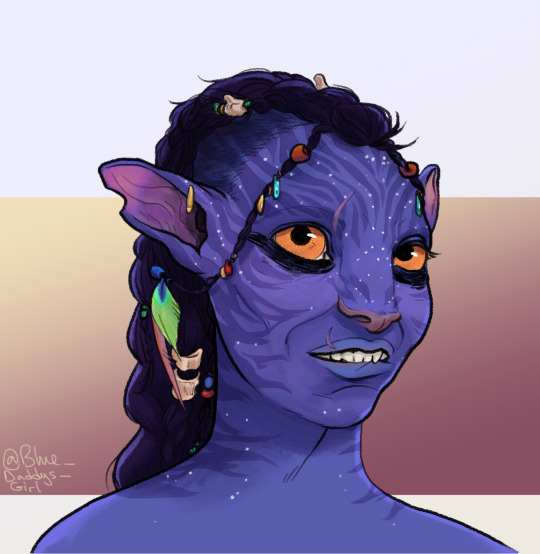
Meet Kesa of the txepìva
Kesa is one of the ash Na'vi, from a txepìva clan. She lives along an enormous volcanic fault with constant eruptions. The soil is very rich there, but due to the instability of their home, Kesa's people are nomadic. As a result, there can be fierce competition for resources.
Kesa is a Claimer. She scouts ahead of her clan with a small band in search of old or new oasis that will provide foraging, hunting, and water. If they encounter a party from another clan, they will engage in ritualistic combat.
As a warrior, it's Kesa's speciality. She's an alright hunter, but she was trained to fight and kill other Na'vi specifically. If the claiming party makes a strong, frightful display, they might win the location and chase off the other tribe. If not, they'll alert their own to divert their path.
If things are desperate enough, clans might face off in actual combat. Conditions are much harsher along the volcanoes.
Txepìva Na'vi have darker skin with purplish stripes. Due to frequent low visibility caused by ash clouds and smoke, they have larger eyes, of a deep amber-red colour, and larger ears than their forest counterparts. Their nostrils are also wider, but can be closed completely shut. They share a good breathing capacity with the Metkayina, as they may cross patches of toxic gas and have to get under cover/upwind. Their sense of smell is the most acute of all Na'vi.
They don't practice war paints, but they make thick mixtures they smear around their eyes to help combat irritation from ash and gases and wards against insects.
Unlike other clans, Txepìva Na'vi have three leaders. One leads the clan according to memory. They keep track of their progress through the year, and the movements of the volcanoes and lava flows. They work closely with the Claimers/Scouts, as does the war leader. That leader has a more minor role, activated only when the clan decides to fight. At such times only the war leader's decisions are followed, to reduce confusion and division. The final leader is their Tsahìk.
Txepìva clans have no central leader, the way Tonowari has influence over other villages. How peaceful they are entirely depends on how resource rich the environment is at the time.
The Txepìva use no ikran or pa'li. Food is just too scarce and they aren't native to the volcanic plains. However they hunt alongside cousins of the nantang (viperwolf) that live in small family packs, are larger and adapted to desertic conditions. They also use birds, mated pairs that travel with them and use tsaheylu to communicate what they've seen from the sky. It's not uncommon for a young couple of Claimers to be gifted a pair of such birds, helping them to work in tandem over great distances, using them a lot like humans would messanger pigeons.
As you may imagine, Txepìva Na'vi are extremely powerful distance runners. They're one of the few Na'vi to favour shoes, which they make by braiding a fire resistant plant, and use to tread over lava flows that aren't fully cooled and over obsidian ground. They also value metal tools and have several RDA issue items in constant rotation among them as they get bartered and borrowed.
The Txepìva are masters of using fire to hunt, cornering animals and using smoke to asphyxiate, but also poison. They brew strong toxins and apply them to arrows (they use short, sturdy bows), or blow darts. When you don't have a lot of prey, you have to kill it, and fast. Though they remove contaminated flesh around the wound, Txepìva meat has a reputation for being unpalatable to strangers because of remaining toxins. The ash people have long since gained immunity and don't notice it.
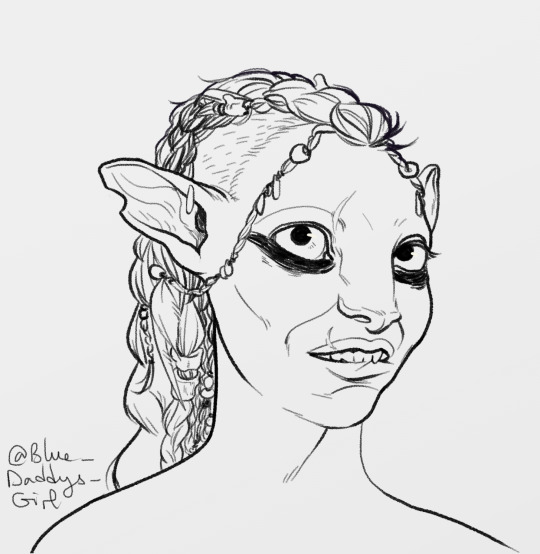
Have some lineart~
#avatar lore#all 100% made up#use freely and build on it#credit appreciated#asks open for more#avatar 2#avatar the way of water#avatar 3#which will disprove all of this#avatar oc#na'vi#na'vi oc#fem na'vi#fanart#na'vi life#my art#james cameron gimme a job#please
266 notes
·
View notes
Text

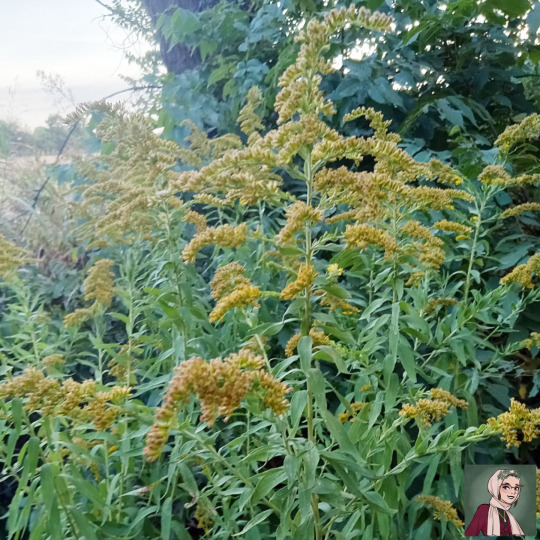
Instagram Repost: October 6, 2022
Absolutely horrible photos because the wind picked up just as I found it … But I was so excited to find a patch of what I believe's Tall Goldenrod (Solidago Gigantea) out at the farm when we went out looking for Pears for Hagging Out a while back now.
I've never actually seen Goldenrod in the wild and it really was an Experience™ because it was all damned near as tall as I was; to find a whole small meadow of it just at its peak before bloom, gently swaying in the evening wind and sun, was absolutely stunning. I wish I could have seen it after this in full bloom and harvested a bit of it. But alas, not for me. Maybe some day I'll be able to get back out there at peak time and get some seeds, though!
#ReTaming The Farm#Instagram Reposts#2022#Personal#Great Plains Foraging#Herbalism#Oklahoma#Casual Reminder That Oklahoma Is NOT A Midwestern OR Southwestern State#Prairie Magic & Medicine
9 notes
·
View notes
Text


Andrena nasonii. Abundant, late spring to early summer; global range runs from the Maritimes to southern Ontario south through the Great Lakes and largely fades at the Great Plains, but with scattered records to the edge of the Rockies, runs south to East Texas, but apparently absent from the delta and lower coastal plain regions of the South as well as the Florida Peninsula; essentially ubiquitous, occurring in forests, fields, agriculture, suburban, and urban sites of all types where it forages on what would appear to be almost every woody and herbaceous blooming plant available, a common denizen of lawns, roadsides and disturbed areas; no management really needed for this species!
23 notes
·
View notes
Text
Fossil Novembirb 14: Lost in the Woods

Eurotrochilus by @iguanodont
Even though parts of the landscape were opening up, the forests of Europe weren't done yet - in fact, many began transitioning to the drier temperate forests we know from Europe today! This transition through the Oligocene would have major consequences for bird evolution - I mean, why else would I bring it up? The formation of the first permanent ice sheets in Antarctica made the world drier, and in turn lead to many of the European Islands of the Eocene connecting with one another, forming an actual continent. Well, sub-continent.
So we saw h ow birds were adapting to the plains - how did they adapt to the temperate forests? Well, by more modern groups appearing, too! In fact, this was a busy period of evolution for most animals, as early forms gave way to modern clades and the early adapations that make those clades unique begin to pop up.

Aviraptor by @otussketching
Eurotrochilus, known from Germany during the Oligocene, is a prime example of this phenomenon: it looks almost identical to living hummingbirds, but - unlike living hummingbirds - it was in Europe, not the Americas! Though it wasn't quite a modern hummingbird, having long finger bones like ancestral forms, it had the adaptations needed for feeding on nectar and hovering while foraging for food. As a pollinator, it would have been a key component of the forest ecosystem, helping to pollinate flowering plants and keeping the forest growing. It was also exceptionally common, and may have lead to many plants co-evolving with hummingbirds in the Eastern Hemisphere - so that when hummingbirds disappeared from the region, the niche was left open for the passerine Sunbirds to one day fill it.
We also start to see more and more flighted birds of prey, like Aviraptor. Though small in size, it had long slender legs and sharp talons, and was thus the first raptor adapted for eating other birds as prey - to capture them in the air mid-flight. Sure, it mainly ate small ones, but we all have to start somewhere! And, with all of those lovely hummingbirds and early passerines and barbets around, it certainly had enough food to eat.
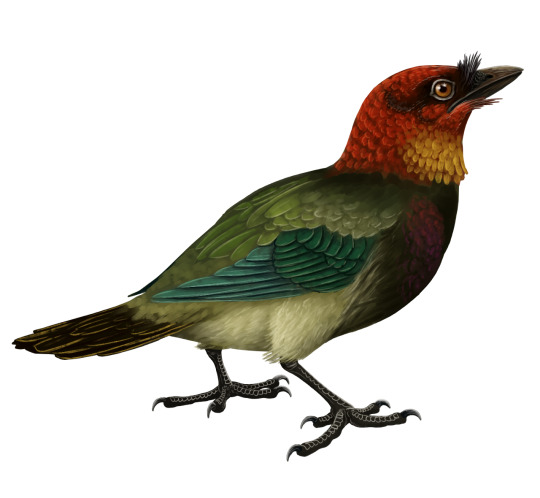
Rupelramphastoides by @drawingwithdinosaurs
Yep, I said barbets - the earliest known barbet-like bird comes from the Oligocene European Forests, Rupelramphastoides. One of the smallest members of the Toucan-Barbet group, it had a lot of very modern traits from the group for its early evolution - including long and slender foot bones like living Toucans! It had a small beak, like barbets, and squat wings for flitting about between the trees. Like its living relatives, it probably ate fruit - which would have been plentiful - as well as insects.
Wieslochia, which I discussed on Passerine day, was also present in these forests - it was just a great place for modern tree-dwelling birds to really get their start! Relatives of hoopoes and hornbills, like Laurillardia, were also present - and had long wings and tails, probably for display in addition to movement. Palaeotodus was present in these forests as well as in the savannah, indicating that it was flexible in its preferred habitat - like the living todies of the Caribbean today. Why todies today are only limited to the Caribbean islands, however, remains a mystery.

Oligocolius by @quetzalpali-art
Mousebirds haven't been limited to their modern range yet, either! Though not a Sandcoelid, Oligocolius was a weird Mousebird with the hooked bill of a modern parrot! So, clearly, Mousebirds were experimenting with lots of different niches prior to the modern day - and this is a neat example of convergent evolution to boot! It had a crop, unlike its living relatives, which allowed it to digest tougher plant material. It was common in its environment, found both in the forests and in more lacustrine and coastal areas, indicating it was flexible in this changing world - an extremely helpful adaptation as the ecosystems evolved!
Primotrogon, an early relative of trogons, breaks the pattern of "Like Modern Relatives but Slightly Off" that we've been seeing with these birds - unlike living trogons, it had long wings, a short tail, and small eyes! In addition to it's weirdness, we actually know the color of this bird - it had green secondary coverts, with grey secondaries and primary coverts, though the color of the primaries is not known. Given the rareness of green in animal colors, but how commonly it comes up in birds, this is another example of that phenomenon!
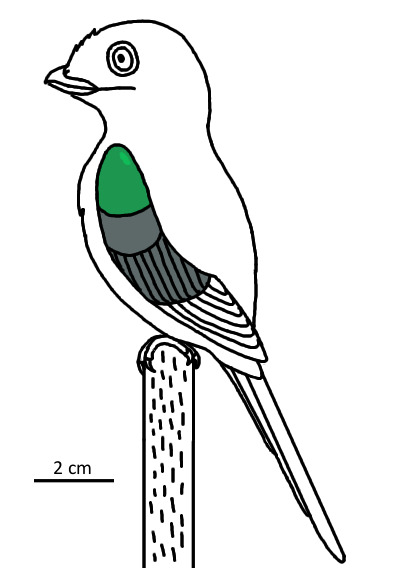
Primotrogon by @albertonykus
Tree dwelling birds aren't the only birds that live in forests, and they aren't the only ones that underwent radiation during this period of environmental change. A weird group of "shorebirds", the Buttonquails, first appears in this ecosystem in the form of Turnipax. Like quails, they are small round ground dwelling birds, but weirdly, their closest relatives are gulls and sandpipers! Turnipax seems to have already been much like its modern relatives, and its possible that the lower diversity of landfowl allowed other avian groups to fill these niches. Rupelornis, a relative of albatross, also lived in the forests of this time - and probably was an ocean going bird, living like modern storm petrels and plucking food carefully from the surface of the water. Like other sea birds, it may have been in forest habitats for the protection - for nesting, rearing young, or other activities. It's a lot easier to hide in the trees than it is to hide at the beach!
This time of environmental turmoil gave dinosaurs new opportunities to diversify - and required flexibility to do so, as the landscape ebbed and flowed between savannah and forest much as it does today. Alas, the climate would not remain stable, and as we continue through the Cenozoic, more and more ecological turmoil will continue to have lasting effects on the evolution of living dinosaurs.
Sources:
Mayr, 2022. Paleogene Fossil Birds, 2nd Edition. Springer Cham.
Mayr, 2017. Avian Evolution: The Fossil Record of Birds and its Paleobiological Significance (TOPA Topics in Paleobiology). Wiley Blackwell.
38 notes
·
View notes
Text
Birds of Estolad
Written for @melestasflight
Flora, fauna, geography and environment Masterlist
Other bird posts: Himlad, The March
Other information in the Estolad tag including my environment posts
I love doing general flora and fauna posts but I can’t fit everything in them so I’m trying to make more specific ones as well! please please feel free to send categories to work on with locations! Or any environmental world building asks!
Estolad is a region in Northeastern Beleriand. It was a wide plain located between the river Aros on the west and the river Gelion on the east. It was south of the March of Maedhros and north of the Andram.
We have little canonical information about the environment or ecology of Estolad. For this post, I have primarily used the environmental information for other locations in Eastern Beleriand (though it should be noted that the climate of Ossiriand does differ greatly from the areas between the March and Maglor’s Gap and the Andram). I have also used geographic information and the environmental world building I’ve previously done
Tolkien primarily used plains, prairies and grasslands of North America and parts of Europe and Asia
Like my other similar posts, I’ve included world building notes at the end so it’s not just a list of species! A lot of aspects and species are similar to Himlad but I didn’t repeat all of the same because I didn’t want to get too repetitive! Because of this, I don’t have quite as many birds and some of my notes are a little more frivolous which I apologize for
On the plain: common quail, corn bunting, common buzzard, steppe eagle, hazel grouse, grey partridge, pallid harrier, steppe eagle, black grouse, great grey strike, crested lark, golden eagle (rare), common cuckoo (migratory), lesser kestrel, great bustard, pale backed pigeon, imperial eagle, white throated bushchat
Water birds (on the river banks, in wetlands closer to the Andram and Ossiriand, and in small lakes and ponds): white stork (migratory), common crane, mallard duck, white tailed eagle, water rail, glossy ibis, common loon, gadwell
In trees around the rivers and by the Andram: long eared owls, common bullfinch, grey wagtail, mountain accentor (in the north and south of the region), common hoopoe (migratory), little owl, grey headed woodpecker, common raven, merlin, common golden oriole, common nightjar
World building notes:
-The Noldorin host of Estolad rely on birds for food (meat and eggs), feathers (for down, quills, etc) and companionship/aid
--Among the Noldor in Estolad, birds of prey are used for hunting. The species most commonly used are the pallid harrier and the steppe eagle
-The small population of green elves in Estolad do not eat birds however they do eat eggs of some species including ones they’ve domesticated. They also use feathers in and on clothing and with down.
-Birds are common in the folklore, language and art of both elven peoples of Estolad. Though most of the established Noldorin lore originated before their settling there, some tales and phrases and art do develop among their host. Some of these develop in connection to the lore and traditions of the green elves there
One such tradition are styles of paintings of birds, similar to the bird and flower or Huaniaohua in the real world. These developed in part inspired by spoken poetry and song by the green elves, particularly those related to their spring gatherings.
-The green elves of Estolad likewise have an abundance of lore and beliefs about the animals around them including many about birds and symbolic meaning given to species. White storks for example are symbolic of approaching death, winter or other natural changes of a somber nature. Common golden orioles are signifiers of late summer and early autumn. They are associated with the increased pressure to forage and store food for the winter and their image often appears on the cloth bags that hold certain items
-There is a tiny lake near where the initial settlements by Amrod and Amras’s host was. During the first spring, baby cranes were seen on the water. Some of the advisers and higher ups became very fond of the little family.
-Estolad was also inhabited by humans. Several cultures lived there for a time after coming west from over the Ered Luin. Just like other aspects of the environment and life of Estolad, the birds of Estolad entered the lore and knowledge of the Edain hosts, combining and joining with the lore and knowledge from their old homes beyond the Ered Luin.
Note: I want to go more in to their relationship of the humans here with the environment, including with birds on another post so I can do that in more depth 
25 notes
·
View notes
Text
I have such a specific kind of game I want to play that I just cannot find anywhere on Steam (or PS4/Switch). There are one or two elements of it in various existing games, but not all (or many) in one.
I want a cottagecore farming & witchy sim with:
‘realistic’ looking, 1st and/or 3rd person POV like Skyrim, Horizon (ZD &FW), Witcher III, Dragon Age Inquisition etc (not cartoon/pixel style like Animal Crossing or Stardew). This is the most important thing that I want and can’t find - there are loads of great looking cutesy things out there (My Witchy Life, Little Witch in the Woods, Wytchwood, Wylde Flowers etc.) but that’s not what I’m looking for (their style is sweet but it sort of hurts my eyes after a while, even Stardew).
open world
make your own character from scratch (not play as a prescribed character) with lots of physical and gender options
lots of great weather effects and changing seasons (like some of the weather mods for Skyrim)
build your own house (modular like Skyrim Hearthfire DLC or Sims)
ability to craft items or buy items to decorate your home according to various styles/tastes/aesthetics
variety of plants/herbs to grow in a garden plus more to forage in the surrounding countryside
things to make/craft/bake (potions, salves, medicines, food, treats, meals)
beekeeping?
animal keeping/breeding?
lots of different witchy familiar options to bond with (maybe depending on the ‘biome’ where you first set up the house/start the game - forest: deer, owl, mouse, fox; tundra: wolf, eagle, raven; coastal: seal, dolphin, puffin; plains: horse, wolf, big cat etc. etc.)
cute village nearby to interact with - shops, upgrade tools, buy rare seeds, trade etc.
option to romance any villager but no obligation to do so (like Stardew)
no combat/angst/stress/quests with ‘bad’ endings
a few seasonal events - fairs, fetes, competitions, markets etc.
witchy/monstery friends (like Krobus and Dwarf in Stardew, but... more? Spirits in the woods/mines/sea/grasses etc. Or if the world is a fantasy one and not all-human, then lots of non-human villagers to be friends with)
That’s... a lot, I realise, but if someone made this game (or like a complete overhaul mod for Skyrim that was literally just that), I would buy it immediately and never leave (and stream it on Twitch every day for the rest of my life!).
135 notes
·
View notes
Text
Animabri
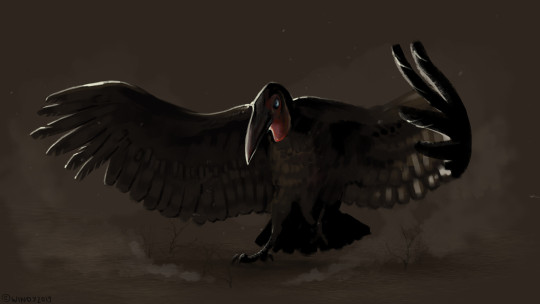
“Southern ground hornbill” © ArtStation user “Reptile without any name”. Accessed at their ArtStation here
[Animabri appears in the creation myths of the Krachi people of Togo and Ghana; specifically, he is the first creature to kill humans. In Harold Scheub’s A Dictionary of African Mythology, Animabri is referred to as a “giant ground toucan”. Which is not a thing that exists, and if it did, wouldn’t exist in Africa. It’s a hornbill. So this entry pulls in some other ground hornbill lore from throughout Africa to round out what I could only find passing references to.]
Animabri
CR 9 CE Magical Beast
This great black bird has an oversized beak with a short crest at its base. Colorful patches of bare flesh mark its face, and hang from its neck in a wattle.
The animabris are sinister avian predators that resemble a ground hornbill the size of an elephant. They have powers over death and misfortune, and people where animabris roam are leery of even mundane hornbills. Although they are fully flighted, an animabri is not very agile in the air, so spends most of its time on the ground. Animabris have incredibly keen vision, and ignore invisibility and illusions. They use this in their pursuit of small game. “Small” in this case is proportionate to the animabri, so includes creatures such as antelope, wild pigs and people.
An animabri is shrouded by a perpetual aura of misfortune. Most creatures are cursed by its mere presence, making fighting back against such a beast difficult. This curse of misfortune is temporary, but a well-placed peck or claw can bestow a more permanent curse on an enemy. Victims slain by an animabri have their souls severed from their bodies, making them harder to raise from the dead. Incorporeal undead tend to be more common than usual in animabri country, although the monstrous birds do not associate with such restless spirits.
Most animabris live in social units consisting of a single family—a mated pair and their adult children. These families are insular and clannish. They fight to the death with other animabris over hunting territory. Only when the parents grow old does the family split up, each member trying to find a mate to start its own little clan. Despite their group living, they are more competitive than cooperative when it comes to foraging, and may bicker over a choice meal or trinket. Animabris are interested in treasure, but have little idea of value. Their hoards contain the most brightly colored and shiniest objects they can find, regardless of their actual worth.
An animabri can live around 40-50 years. They can speak Common, which they use primarily to deliver threats and boasts.
Animabri CR 9
XP 6,400
Init +7; Senses darkvision 60 ft., low-light vision, Perception +21, true seeing
Aura misfortune (30 ft., DC 17)
Defense
AC 23, touch 13, flat-footed 18 (-2 size, +4 Dex, +1 dodge, +10 natural)
hp 115 (11d10+55)
Fort +12, Ref +11, Will +9
DR 10/magic; Immune curses, death effects, negative energy, patterns, phantasms
Offense
Speed 30 ft., fly 50 ft. (poor)
Melee bite +15 (2d6+6/19-20 plus grab), 2 claws +15 (1d6+6)
Space 15 ft.; Reach 10 ft.
Special Attacks cursed critical, sever life
Statistics
Str 22, Dex 19, Con 21, Int 8, Wis 19, Cha 14
Base Atk +11; CMB +20 (+24 grapple); CMD 34
Feats Critical Focus, Dodge, Improved Critical (bite), Improved Initiative, Multiattack, Power Attack
Skills Fly +6, Perception +21; Racial Modifiers +8 Perception
Languages Common
Ecology
Environment warm forests and plains
Organization solitary, pair or party (3-6)
Treasure incidental
Special Abilities
Aura of Misfortune (Su) All creatures within 30 feet of an animabri must succeed a DC 17 Will save or be cursed with misfortune, rolling all d20 rolls twice and taking the worse result. This effect lasts for as long as the creature remains within 30 feet of the animabri, and for 1d4+1 rounds thereafter. A creature that succeeds its save is immune to that animabri’s aura of misfortune for the next 24 hours. This is a curse effect, and the save DC is Charisma based.
Cursed Critical (Su) If an animabri successfully confirms a critical hit against an opponent, that creature must succeed a DC 17 Will save or be cursed (as per bestow curse—the animabri chooses the effect). The save DC is Charisma based.
Sever Life (Su) A creature that is killed by an animabri is difficult to return to life; such a creature can only be raised or resurrected with a successful DC 24 caster level check. This is a curse effect.
True Seeing (Su) An animabri gains the constant benefits of a true seeing spell as a supernatural ability.
66 notes
·
View notes
Text
Thedas Scaling vs Real World Scaling
I am once again bothering everyone and their mutuals about how small Thedas is scaled and how it is roughly 200k miles (321,869 km) bigger than Greenland, and 65, 998 miles (106.2k km) larger than Algeria.
A continent that is supporting at least 10.01 million people who range from 4'9 - 8' (1.44 - 2.43 m) in addition to all the mega fauna (dragons, giants, great bears, wyverns, wandering hills, ect.)
To be clear, I'm not saying that a land mass this size couldn't support 10.01 million people. It likely could if you reference the pre-plague numbers of England of which Ferelden is the approximate size of, and Thedas is roughly 12 Fereldens. The population estimate for England was around 1.5 million or more in 1086 and grew to between 3.7 million and 5–7 million. If we go low ball and go with the 1.5 million with the high ball of 7 million, Thedas could potentially support 18-84 million people.
There are many issues with this though, the first one being that when you consider the fact that a large swath is uninhabitable or are unsustainable for large populations; Western Approach, Silent Plains, the Anderfels, and a portion of blighted lands between Antiva and Rivain. Which knocks out roughly 1 Ferelden worth of land. So, subtracting the respective amount leaves us with 16.5-77 million of potentially supported population.
The second issue, is again the mega fauna. Dragons need large amounts of food. Their drakes go out and hunt for food for them, their brood, and the drakes themselves while the high dragon is in her nest. She then goes and eats in vastly larger amounts before she lays a clutch. Considering the size of dragons and that we know there are/were at least 12 at one point. That's a lot of land they'd need to support themselves and their brood.
Then you have giants, wyverns, regular bears, great bears, pheonix, quillback, hyenas, and more. If we focus on bears, such as the great bear which preys on wyverns and dragons and their size, along with the much larger than the average Thedosian bear - which are larger than the largest bear irl who's shoulders average at 5' (153cm) which would be as tall as Varric whose game model is 5' (153cm). The bears themselves would need massive amounts of space to forage and/or hunt. Especially in preparation for winter.
This makes it so Thedas couldn't support the minimum population size it would have of 10.01 million people with the amount of mega fauna it has without extreme clashes near daily without them being hunted to extinction. Which we know they almost did with dragons.
But these are a lot of numbers right? And really how big are those countries I mentioned? Well, here is Algeria (Blue), Greenland (Green), and America (Orange) overlayed over Europe for perspective using The True Size site.
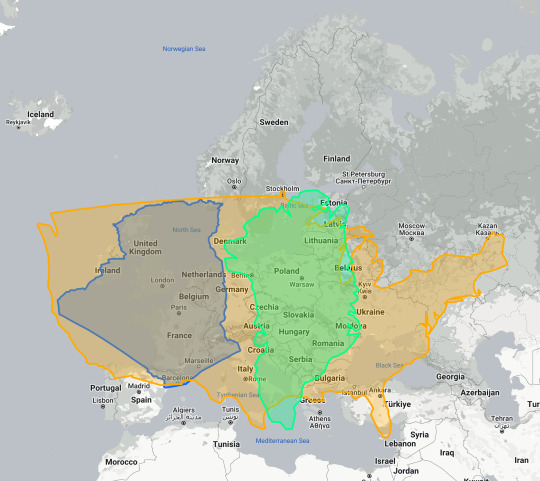
For clearer idea of what this looks like on an individual level:
Greenland vs America
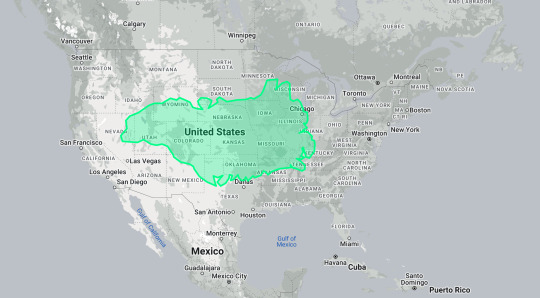
Algeria vs America
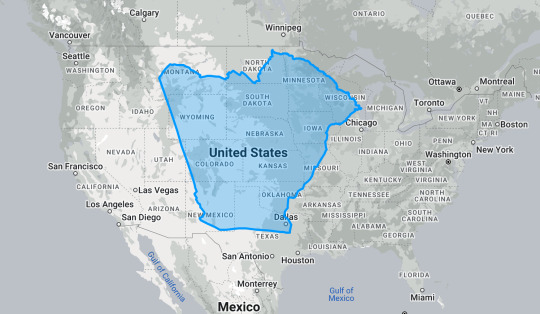
America vs Europe
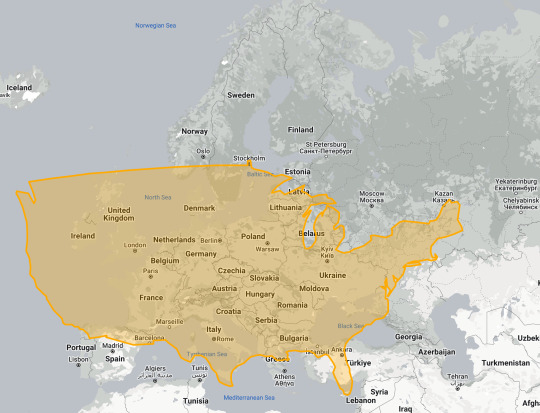
#Archi shouting into the void#Archi is yelling#I am once again making the Thedas scaling issue your problem as well as mine#It's also fascinating to consider just how much larger Thedas actually is to have tundra in the south and how it would expand#I'm only half joking....kinda#Thedas is too small and I resent the assertion that it can support the amount of life it has when it's barely able to support double the po#long post
10 notes
·
View notes
Text
BOTD: Lapland Longspur

Photo: Gregory "Slobirdr" Smith
"Found throughout the Arctic zones of Europe, Asia, and North America in summer, this is one of the most abundant breeding birds of the far North. Birders who visit the tundra in summer will find Lapland Longspurs very common almost everywhere there, the bright males singing their short warbling songs from hummocks or rocks or while flying. In winter the birds come south in flocks, to forage in windswept fields. Although they range widely across the continent, the vast majority winter on the Great Plains, where flocks in the thousands seem to reflect the abundance of the species on its northern nesting grounds."
- Audubon Field Guide
#birds#lapland longspur#birds of north america#north american birds#birds of the us#birds of canada#longspur#longspurs#birds of america#american birds#passerines#bird#birding#bird watching#birdblr#birblr#bird of the day#Calcarius lapponicus
43 notes
·
View notes